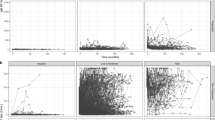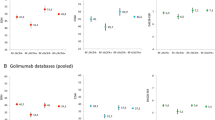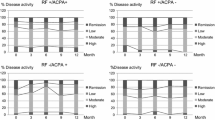Abstract
Autoantibodies in early rheumatoid arthritis (RA) have important diagnostic value. The association between the presence of autoantibodies against cyclic citrullinated peptide and the response to treatment is controversial. To prospectively evaluate a cohort of patients with early rheumatoid arthritis (<12 months of symptoms) in order to determine the association between serological markers (rheumatoid factor (RF), anti-citrullinated protein antibodies) such as anti-cyclic citrullinated peptide antibodies (anti-CCP) and citrullinated anti-vimentin (anti-Sa) with the occurrence of clinical remission, forty patients diagnosed with early RA at the time of diagnosis were evaluated and followed for 3 years, in use of standardized therapeutic treatment. Demographic and clinical data were recorded, disease activity score 28 (DAS 28), as well as serology tests (ELISA) for RF (IgM, IgG, and IgA), anti-CCP (CCP2, CCP3, and CCP3.1) and anti-Sa in the initial evaluation and at 3, 6, 12, 18, 24, and 36 months of follow-up. The outcome evaluated was the percentage of patients with clinical remission, which was defined by DAS 28 lower than 2.6. Comparisons were made through the Student t test, mixed-effects regression analysis, and analysis of variance (significance level of 5%). The mean age was 45 years, and a female predominance was observed (90%). At the time of diagnosis, RF was observed in 50% of cases (RF IgA—42%, RF IgG—30%, and RF IgM—50%), anti-CCP in 50% (no difference between CCP2, CCP3, and CCP3.1) and anti-Sa in 10%. After 3 years, no change in the RF prevalence and anti-CCP was observed, but the anti-Sa increased to 17.5% (P = 0.001). The percentage of patients in remission, low, moderate, and intense disease activity, according to the DAS 28, was of 0, 0, 7.5, and 92.5% (initial evaluation) and 22.5, 7.5, 32.5, and 37.5% (after 3 years). There were no associations of the presence of autoantibodies in baseline evaluation and in serial analysis with the percentage of clinical remission during follow-up of 3 years The presence of autoantibodies in early RA has no predictive value for clinical remission in early RA.
Similar content being viewed by others
References
Sokka T, Envalds M, Pincus T (2008) Treatment of rheumatoid arthritis: a global perspective on the use of antirheumatic drugs. Mod Rheumatol 18:228–239
Smolen JS, Aletaha D (2008) Activity assessments in rheumatoid arthritis. Curr Opin Rheumatol 20:306–313
Boire G, Cossette P, de Brum-Fernandes AJ et al (2005) Anti-Sa antibodies and antibodies against cyclic citrullinated peptide are not equivalent as predictors of severe outcomes in patients with recent-onset polyarthritis. Arthritis Res Ther 7:R592–R603
Vázquez I, Graell E, Gratacós J, Cañete JD, Viñas O, Ercilla MG (2007) Prognostic markers of clinical remission in early rheumatoid arthritis after two years of DMARDs in a clinical setting. Clin Exp Rheumatol 25:231–238
Verschueren P, Esselens G, Westhovens R (2009) Predictors of remission, normalized physical function, and changes in the working situation during follow-up of patients with early rheumatoid arthritis: an observational study. Scand J Rheumatol 23:1–7
Gossec L, Dougados M, Goupille P, Cantagrel A, Sibila J, Meyer O (2004) Prognostic factors for remission in early rheumatoid arthritis: a multiparameter prospective study. Ann Rheum Dis 63:675–680
Mancarella L, Bobbio-Pallavicini F, Ceccarelli F et al (2007) Good clinical response, remission, and predictors of remission in rheumatoid arthritis patients treated with tumor necrosis factor alpha blockers: the GISEA study. J Rheumatol 34:1670–1673
Bas S, Genevay S, Meyer O, GAbay C (2003) Anti-cyclic citrullinated peptide antibodies, IgM and IgA rheumatoid factors in the diagnosis and prognosis of rheumatoid arthritis. Rheumatology 42:677–680
Serdaroflu M, ÇakÂrbay H, Defer O, Cengiz S, Kul S (2008) The association of anti-CCP antibodies with disease activity in rheumatoid arthritis. Rheumatol Int 28:965–970
Escalona M, López-Longo FJ, Gozález CM et al (2002) Anti-Sa sera from patients with rheumatoid arthritis contain at least 2 different subpopulations of anti-Sa antibodies. J Rheumatol 29:2053–2060
Wagner E, Skoumal M, Bayer PM, Klausofer K (2009) Antibody against mutated citrullinated vimentin: a new sensitive marker in the diagnosis of rheumatoid arthritis. Rheumatol Int 29:1315–1321
Author information
Authors and Affiliations
Corresponding author
Rights and permissions
About this article
Cite this article
da Mota, L.M.H., dos Santos Neto, L.L., de Carvalho, J.F. et al. The presence of anti-citrullinated protein antibodies (ACPA) and rheumatoid factor on patients with rheumatoid arthritis (RA) does not interfere with the chance of clinical remission in a follow-up of 3 years. Rheumatol Int 32, 3807–3812 (2012). https://doi.org/10.1007/s00296-011-2260-9
Received:
Accepted:
Published:
Issue Date:
DOI: https://doi.org/10.1007/s00296-011-2260-9




